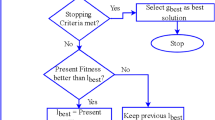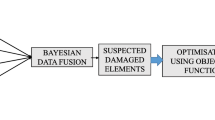Abstract
Main complexities of classical health-monitoring techniques, such as modal strain energy (MSE) and modal curvature (MCR), are noise sensitivity and false alarming. On the other hand, the modern techniques, such as model updating, become very complex for a large number of variables and large search space. In this present study, a new health-monitoring technique based on the combination of MSE and model updating is presented for fast and accurate identification of structural damage. In this technique, the probable locations of an unknown damage are determined using MSE-based damage index (MSEDI). The effect of noise is reduced by passing the vibration data through Morlet wavelet filter. In this context, the peaks of the MSEDI in the wavelet domain are considered as the suspicious locations of damages. The exact location and the severity of the damage are then determined by applying model updating technique. To achieve this, reduction of stiffnesses at the probable locations is considered as the updating variable. The objective function is developed using MCR in wavelet domain and minimized by particle swarm optimization technique. The final updated values of the stiffnesses at those locations represent the actual locations and severity of the damage. The technique is applied on a simulated single-storied plane steel frame structure and a similar experimental model with welded joints for single and multiple damage scenarios. The damage was introduced either near to or away from the joints by making saw-cut grooves representing loss of stiffness. The results depict the effectiveness of the technique for potential application in real-life structures.












Similar content being viewed by others
References
Doebling SW, Farrar CR, Prime MB, Shevitz DW (1996) Damage identification and health monitoring of structural and mechanical system in their vibration characteristics: a literature review. Los Alamos National Laboratory, New Mexico
Farrar CR, Doebling SW (1997) An overview of modal-based damage identification methods. In: Proceedings of DAMAS conference, Sheffield, UK
Pal J, Shah V, Banerjee S (2013) Performance of damage detection algorithms for health monitoring of joints in steel frame structures using vibration-based technique. Int J Struct Eng 4(4):346–360
Shi ZY, Law SS, Zhang LM (1998) Structural damage localization from modal strain energy change. J Sound Vibrat 218(5):825–844
Shi ZY, Law SS, Zhang LM (2002) Improved damage quantification from elemental modal strain energy change. ASCE J Eng Mech 128(5):521–529
Li H, Yang H, Hu SLJ (2006) Modal strain energy decomposition method for damage detection of an offshore structure using modal testing information. ASCE J Eng Mech 132(9):941–951
Hu SJ, Wang S, Li H (2006) Cross modal strain energy method for damage localization and severity estimation. In: Proceedings of the international conference on offshore mechanics and arctic engineering—OMAE 2:245–249
Li H, Yang H, Hu SLJ (2007) Damage localization and severity estimate for three-dimensional frame structures. J Sound Vibrat 301(3–5):481–494
Friswell MI, Penny JET, Garvey SD (1998) Combined genetic and Eigen-sensitivity algorithm for the location of damage in structures. Comput Struct 69(5):547–556
Perry MJ, Koh CG, Choo YS (2006) Modified genetic algorithm strategy for structural identification. Comput Struct 84(8–9):529–540
Perera R, Ruiz A, Manzano C (2007) An evolutionary multiobjective framework for structural damage localization and quantification. Eng Struct 29(10):2540–2550
Perera R, EnFang S, Huerta C (2009) Structural crack detection without updated base line model by single and multi-objective optimization. Mech Syst Signal Process 23(3):752–768
Zhang Z, Koh CG, Duan WH (2010) Uniformly sampled genetic algorithm with gradient search for structural Identification—part I: global search. Comput Struct 88(15–16):949–962
Zhang Z, Koh CG, Duan WH (2010) Uniformly sampled genetic algorithm with gradient search for structural Identification—part II: local search. Comput Struct 88(19–20):1149–1165
Meruane V, Heylen W (2011) An hybrid real genetic algorithm to detect structural damage using modal properties. Mech Syst Signal Process 25(5):1559–1573
Kennedy J, Eberhart R (1995) Particle swarm optimization. In: Proceedings of IEEE international conference on neural networks 4:1942–1948
Perez REl, Behdinan K (2007) Particle swarm approach for structural design optimization. Comput Struct 85(19–20):1579–1588
Begambre O, Laier JE (2009) A hybrid particle swarm optimization–simplex algorithm (PSOS) for structural damage identification. Adv Eng Softw 40(9):883–891
Orouskhani M, Mansouri M, Teshnehlab M (2011) Average-inertia weighted cat swarm optimization. Advances in swarm intelligence—second international conference. Chongqing, China, pp 321–328
Nanda B, Maity D, Maiti DK (2012) Vibration based structural damage detection technique using particle swarm optimization with incremental swarm size. Int J Aeron Space Sci 13(3):323–331
Xiangcheng M, Haibao R, Zisheng O, Wei W, Keping M (2005) The use of the Mexican Hat and the Morlet wavelets for detection of ecological patterns. Plant Ecol 179(1):1–19
Robinson J, Rahmat-Samii Y (2004) Particle swarm optimization in electromagnetics. IEEE Trans Antennas Propag 52(2):397–407
Elbeltagi E, Hegazy T, Grierson D (2005) Comparison among five evolutionary-based optimization algorithms. Adv Eng Inf 19(1):43–53
Shi Y, Eberhart R (1998) A modified particle swarm optimizer. In: Evolutionary computation proceedings, IEEE world congress on computational intelligence, pp 69–73
Conflicts of interest
The authors declare that they have no conflict of interest.
Author information
Authors and Affiliations
Corresponding author
Rights and permissions
About this article
Cite this article
Pal, J., Banerjee, S. A combined modal strain energy and particle swarm optimization for health monitoring of structures. J Civil Struct Health Monit 5, 353–363 (2015). https://doi.org/10.1007/s13349-015-0106-y
Received:
Revised:
Accepted:
Published:
Issue Date:
DOI: https://doi.org/10.1007/s13349-015-0106-y




